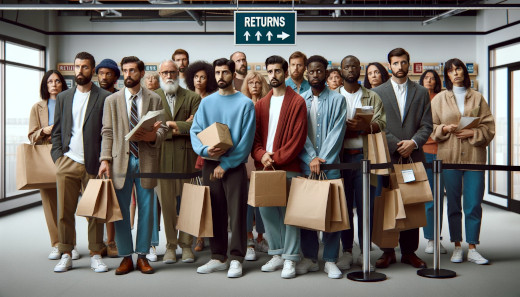Retail Returns Happen - Always Have, Always Will

AI-generated image of a mass of people returning merchandise at a store by DALL-E
Over the Christmas holiday last year, I started reading news stories regarding the increasing volume of returns to both online and brick-and-mortar retailers. In them they discussed the business and logistics of returns to how returns are mounting despite efforts by retailers to curtail them.
On the surface, it sounds like this is a relatively new phenomenon. Most people reading this post have likely returned something to Amazon or some other retailer recently or even this week. The volume of returns has been growing over the years, combining among other reasons the move to buying more items online that – though you can see pictures of it – you are not actually touching the item until you receive it, to simply more competition in the retail space, where you may find a lower price the next day.
However returning merchandise is nothing new. Where I am not a retail industry expert by any stretch, I’d like to share my unique point of view on retail returns as I had some education on this from my Aunt who years ago who worked for a local department store. She was a long-time employee of Steiger’s, a family-owned chain of stores in western Massachusetts and northern Connecticut. They had about a dozen stores in total before they closed down in the early 90s and sold off their stores to Filene’s, eventually to be engulfed by Macy’s.
What’s Old Is...
My aunt’s job at Steiger’s was processing returned merchandise at the company headquarters. Returns would come into her office from all of the stores. Some items were truly damaged or had some defect. Others were still new and just not wanted, and some were likely worn once and then returned as no longer needed. In some cases items were returned to the manufacturer, but often the maker did not want them back and would simply refund the store. Those items were kept and she facilitated a quarterly sale for employees where they could buy the items for pennies on the dollar of their original retail price. Needless to say, we had a lot of items around our house and clothes in our closet from those sales.
When I was old enough to understand about money and how much things cost, my Aunt explained to me about the business of returns and how that fit into the overall cost and pricing of merchandise. She told me, for example, if an item on the rack at the store had a sticker price of $100, the actual cost to Steiger’s for the item may have been as low as $10, of course depending on the brand. That allowed profit to be made with discounts that you see stores offering for 10% to 30% off right-away on new merchandise. It also allowed for profit to be made when the sticker price is reduced over time; even at 50% off a profit can be made. The items on a deep-discount rack were also helping the bottom-line of the store.
After my Aunt came over to our house with things she got from the employee sale – not going to lie, she would set aside things for her sister and niece and nephew – even then there was some profit made by the store. When manufacturers and wholesalers gave credit back to the store it was to offset the fact that they didn’t want the items back or it cost more to ship and process them than their actual value. Rather than throw them away, the 4 times a year sale became an employee perk.
... Not Necessarily New
Now fast-forward to present day. The 800 lb. gorilla in the room, Amazon, has been facing a growing number of returns as, well, people have been buying more from them. They have built an evolving infrastructure to manage them, from returns to Amazon lockers, Kohl’s department stores and UPS Stores to crediting your account now or doing a cash refund days later, to asking more and more questions as to why you are returning an item. Other online retailers are using third-party services for similar drop-off returns, as I have gone to random stores to bring back something from a random online site my kids bought from facilitated by some random service.
As mentioned in the above-linked articles, online and retail stores are also taking steps to try to curtail returns, from shrinking return windows, offering only credit for returns and using third-party services to track frequent returners. But long before Amazon was on the scene, I knew people who would often buy multiple items, say clothing, then try on at home and return the ones they didn’t want. This, of course, being something that required a physical trip to a store, not to mention a lot of time.
Today you can buy something from your mobile device in the time you are stopped at a red light (no, I have never done that, of course not!). The convenience and impulsive nature of doing so drives increased sales, and with that naturally comes the possibility for increased returns. Just this week I returned a lamp I got from my daughter that barely illuminated a small spot on her desk, something we couldn’t have known from the pictures or random reviews on the Web site. Other returns in my household have been for items that just didn’t fit right – how else would you be able to try it on without buying it first?
As I write this, it is a point in time. I am sure I, and everyone else in the world, will continue buying more and returning more. Also as I write this, I am awaiting my return home to a pair of sneakers I bought online... this is the second pair from them, as the one I bought last week were not the right side – I bought the size based on other models from the brand that always fit – and I hope these fit. If not, I am going to return them, likely paying shipping back as the exchange had no added shipping cost (for me) and shop a local store where I can actually try them on.
Do you think about retail returns as much as I have here? That or any other thoughts are welcome in the comments of this post.
Deconstructing Retail Returns
There will always be retail returns. No matter the reason, people want what they want and if they don’t want it they will return it. Efforts to curtail returns could have consequences, and likely will be eased in or built into alternative ways of doing business with a retailer. In a world where every store in the world is literally in the palm of your hand, a long standing part of commerce shouldn’t not be expected.
This is from The Hot Iron, a journal on business and technology by Mike Maddaloni.
Did you enjoy this? Subscribe to The Hot Iron by RSS/XML feed or Read by Email
Business • Strategize • Technology • (0) Comments • Permalink
